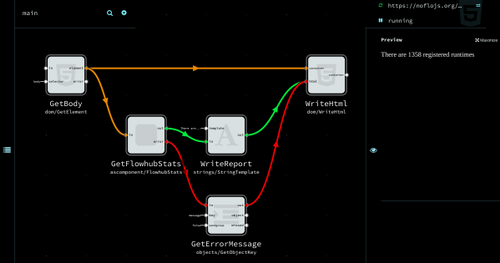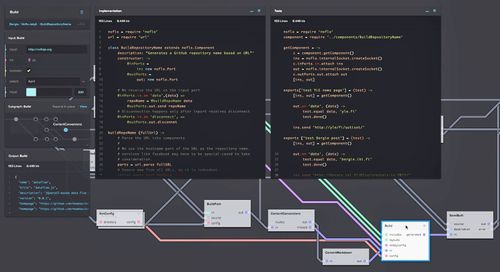asCallback: embedding NoFlo graphs in JavaScript programs
It has always been easy to wrap existing JavaScript code into NoFlo graphs — just write a component that exposes its functionality via some ports.
Going the other way and exposing a NoFlo graph to JS land was also possible but cumbersome. With NoFlo 0.8.3 we now made it super easy with the new asCallback API.
Let’s say you have a graph (or just a component) with the typical IN, OUT and ERROR ports, you can wrap it like this:
// Load the NoFlo module
var noflo = require('noflo');
// Use NoFlo's asCallback helper to prepare a JS function that wraps the graph
var wrappedGraph = noflo.asCallback('myproject/MyComponent', {
// Provide the project base directory where NoFlo seeks graphs and components
baseDir: '/path/to/my/project'
});
// Call the wrapped graph. Can be done multiple times
wrappedGraph({
// Provide data to be sent to inports
in: 'foo'
}, function(err, result) {
// If component sent to its error port, then we'll have err
if (err) { throw err; }
// Do something with the results
console.log(result.out);
});
If the graph has multiple inports, you can provide each of them a value in that input object. Similarly, the results sent to each outport will be in the result object. If a port sent multiple packets, their values will be in an array.
Use cases
With asCallback, you can implement parts of your system as NoFlo graphs without having to jump in all the way. Even with a normal Node.js or client-side JS application it is easy to see places where NoFlo fits in nicely:
- Making complex Express.js or Redux middleware chains manageable
- Adding customizable workflows to some part of the system
- Implementing Extract, Transform, Load (ETL) pipelines
- Porting a system into NoFlo piece-by-piece
- Exposing a pure-JS API for an NPM module built in NoFlo
It also makes it easier to test NoFlo graphs and components using standard, non-FBP-aware testing tools like Mocha.
Network lifecycle
Each invocation of a callbackified NoFlo graph creates its own Network instance. The function collects result packet until network finishes, and then calls its callback.
Since these networks are isolated, you can call the function as many times as you like without any risk of packet collisions.
Promises
Since the callbackified NoFlo graph looks like a typical Node.js function, you can use all the normal flow control mechanisms like Promises or async with it.
For example, you can convert it to a Promise either manually or with a library like Bluebird:
// Load Bluebird
var Promise = require('bluebird');
// Convert the wrapped function into a Promise
var promisedGraph = Promise.promisify(wrappedGraph);
// Run it
promisedGraph({
in: 'baz'
})
.then (function (result) {
console.log(result.out);
});
This functionality is available right now on NPM.

